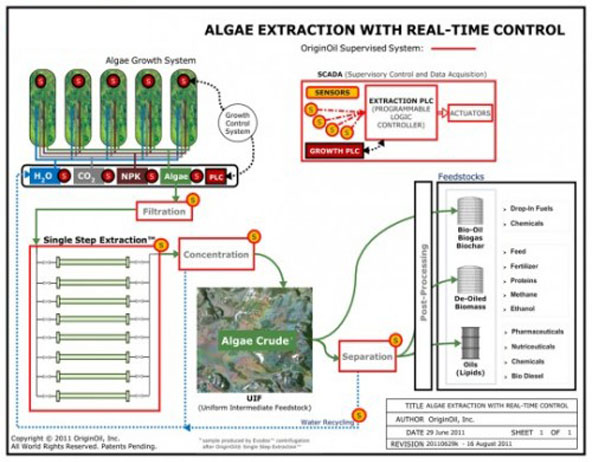
Physical extraction
In the first step of extraction, the oil must be separated from the rest of algae. The simplest method is mechanical crushing. When algae are dried it retains its oil content, which then can be “pressed” out with an oil press. Many commercial manufacturers of vegetable oil use a combination of mechanical pressing and chemical solvent in extracting oil. Since different strains of algae vary widely in their physical attributes, various press configurations (screw, expeller, piston, etc.) work better for specific algae types. Often, mechanical crushing is used in conjunction with chemical solvents, as described below.
Osmotic shock is a sudden reduction in osmotic pressure, this can cause cells in a solution to rupture. Osmotic shock is sometimes used to release cellular components, such as oil.
Ultrasonic extraction, a branch of sonochemistry, can greatly accelerate extraction processes. Using an ultrasonic reactor, ultrasonic waves are used to create catitation bubbles in a solvent material. When these bubbles collapse near the cell walls, the resulting shock waves and liquid jets cause those cells walls to break and release their contents into a solvent. Utrasonication can enhance basic enzymatic extraction. The combination “sonoenzymatic treatment” accelerates extraction and increases yields.
Chemical extraction
Chemical solvents are often used in the extraction of the oils. The downside to using solvents for oil extraction are the dangers involved in working with the chemicals. Care must be taken to avoid exposure to vapors and skin contact, either of which can cause serious health damage. Chemical solvents also present an explosion hazard.
A common choice of chemical solvent is hexane, which is widely used in the food industry and is relatively inexpensive. Benzene and ether can also separate oil. Benzene is classified as a carcinogen. Another method of chemical solvent extraction is Sozhlet extraction. In this method, oils from the algae are extracted through repeated washing, or percolation, with an organic solvent such as hexane or petroleum ether, under reflux in a special glassware. The value of this technique is that the solvent is reused for each cycle.
Enzymatic extraction uses enzymes to degrade the cell walls with water acting as the solvent. This makes fractionation of the oil much easier. The costs of this extraction process are estimated to be much greater than hexane extraction. The enzymatic extraction can be supported by ultrasonication. The combination “sonoenzymatic treatment” causes faster extraction and higher oil yields.
Supercritical CO2 can also be used as a solvent. In this method, CO2 is liquefied under pressure and heated to the point that it becomes supercritical (having properties of both a liquid and a gas), allowing it to act as a solvent.
Other methods are still being developed, including ones to extract specific types of oils, such as those with a high production of long-chain highly unsaturated fatty acids.
Principles of aquaculture and fish farming in including other species such as algae, oyster, seaweed and more- Edited by Laura Vermon from high quality Wikipedia articles (Page 90-91)